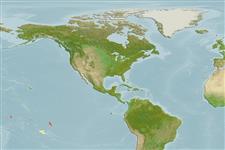Klassifizierung / Names
Namen | Synonyme | Catalog of Fishes(Gattung, Arten) | ITIS | CoL | WoRMS | Cloffa
>
Eupercaria/misc (Various families in series Eupercaria) >
Labridae (Wrasses) > Corinae
Etymology: Coris: Greek, kore, -es = pupil and also with themenaing of "maid" (Ref. 45335); hewetti: Named for J. Hewett, who collected the holotype.
Eponymy: Jeremy Hewett collected the holotype (with a spear) from the reef at the head of Anaho Bay, Nuku Hiva, Marquesas Islands (1957). We have failed to find out more details about him. (Ref. 128868), visit book page.
More on author: Randall.
Environment: milieu / climate zone / depth range / distribution range
Ökologie
seewasser riff-verbunden; tiefenbereich 1 - 40 m (Ref. 33411). Tropical
Eastern Central Pacific: known only from the Marquesas Islands.
Size / Gewicht / Alter
Maturity: Lm ? range ? - ? cm
Max length : 13.9 cm SL Männchen/unbestimmt; (Ref. 33411)
Rückenflossenstacheln (insgesamt) : 9; Rückenflossenweichstrahlen (insgesamt) : 12; Afterflossenstacheln: 3; Afterflossenweichstrahlen: 12.
Found on rubble bottom or substrates with a mixture of sand and rock. Feeds on small benthis invertebrates (Ref. 89972). During courtship, the male roam over a wide area; erect its dorsal fin, compress and expand the caudal fin, and changes its color (Ref. 33411).
Life cycle and mating behavior
Geschlechtsreife | Fortpflanzung | Ablaichen | Eier | Fecundity | Larven
Oviparous, with distinct pairing during breeding (Ref. 205).
Randall, J.E., 1999. Revision of the Indo-Pacific labrid fishes of the genus Coris, with descriptions of five new species. Indo-Pac. Fish. (29):74 p. (Ref. 33411)
IUCN Rote Liste Status (Ref. 130435: Version 2024-1)
Bedrohung für Menschen
Harmless
Nutzung durch Menschen
Tools
Zusatzinformationen
Download XML
Internet Quellen
Estimates based on models
Preferred temperature (Ref.
123201): 27.5 - 29.1, mean 28 °C (based on 109 cells).
Phylogenetic diversity index (Ref.
82804): PD
50 = 0.5000 [Uniqueness, from 0.5 = low to 2.0 = high].
Bayesian length-weight: a=0.00977 (0.00466 - 0.02049), b=3.07 (2.90 - 3.24), in cm total length, based on LWR estimates for this (Sub)family-body shape (Ref.
93245).
Trophic level (Ref.
69278): 3.4 ±0.3 se; based on size and trophs of closest relatives
Widerstandsfähigkeit (Ref.
120179): hoch, Verdopplung der Population dauert weniger als 15 Monate. (Preliminary K or Fecundity.).
Fishing Vulnerability (Ref.
59153): Low vulnerability (10 of 100).
Nutrients (Ref.
124155): Calcium = 69.7 [26.5, 201.0] mg/100g; Iron = 0.706 [0.412, 1.308] mg/100g; Protein = 18.4 [15.6, 20.6] %; Omega3 = 0.153 [0.073, 0.311] g/100g; Selenium = 25.7 [9.5, 74.6] μg/100g; VitaminA = 163 [49, 606] μg/100g; Zinc = 2.44 [1.10, 4.42] mg/100g (wet weight);
